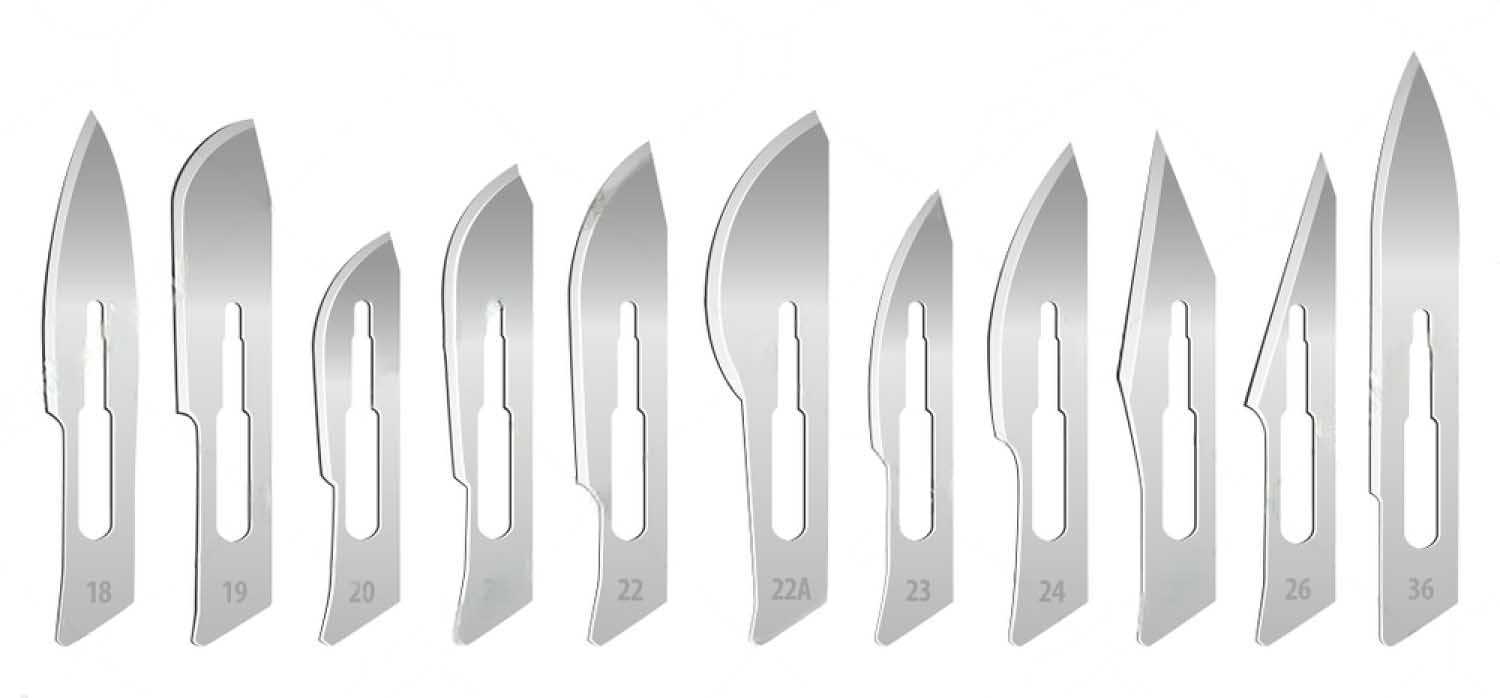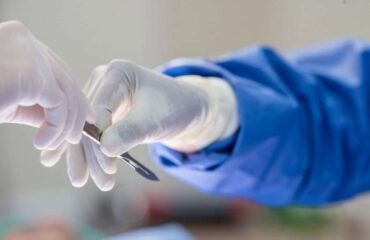Surgical blades are precision-cutting instruments used in medical procedures for making incisions or excisions. They are typically made of stainless steel or carbon steel and come in various shapes and sizes, each designed for specific types of surgical procedures.

Types of Surgical Blades
Surgical blades come in various shapes and sizes, each designed for specific surgical tasks. They are typically classified by a number system and are used with corresponding scalpel handles. Below is a detailed overview of the most commonly used surgical blades and their applications.
Blade #10
Shape: Large, curved cutting edge
Uses:
- Making large incisions in general surgery
- Cutting soft tissues
- Used in procedures such as abdominal surgery and autopsies
Compatible Handles: #3, #3L, #3 Graduated
Blade #11
Shape: Elongated triangular shape with a sharp pointed tip
Uses:
- Stab incisions (e.g., for abscess drainage)
- Creating small, precise incisions in vascular surgery
- Arthroscopic and laparoscopic procedures
Compatible Handles: #3, #3L, #3 Graduated
Blade #12
Shape: Small, crescent-shaped with a curved cutting edge
Uses:
- Removing sutures
- Tonsillectomy procedures
- Dental surgeries
Compatible Handles: #3, #3L, #3 Graduated
Blade #15
Shape: Small, precise blade with a curved edge
Uses:
- Fine, delicate incisions
- Plastic and reconstructive surgery
- Pediatric surgery
Compatible Handles: #3, #3L, #3 Graduated
Blade #20
Shape: Large blade with a curved cutting edge
Uses:
- Making large incisions in orthopedic and general surgery
- Cutting through tough tissues
- Autopsies
Compatible Handles: #4, #4L
Blade #21
Shape: Similar to #20 but slightly larger
Uses:
- General surgical procedures requiring deeper incisions
- Amputation surgeries
Compatible Handles: #4, #4L
Blade #22
Shape: Larger version of the #10 blade
Uses:
- Used for large incisions in general surgery
- Orthopedic and autopsy procedures
Compatible Handles: #4, #4L
Blade #23
Shape: Semi-curved with a longer cutting edge
Uses:
- General surgical procedures
- Used for deeper incisions in abdominal surgeries
Compatible Handles: #4, #4L
Blade #24
Shape: Similar to #23 but slightly wider
Uses:
- Making large, deep incisions
- Post-mortem examinations and orthopedic surgery
Compatible Handles: #4, #4L
Blade #25
Shape: Large and straight with a sharp edge
Uses:
- Major surgical incisions
- Large tissue excisions
Compatible Handles: #4, #4L
Specialty Blades
Apart from standard surgical blades, specialized blades are used for specific medical applications, such as:
- Microblades – Used in ophthalmic and neurosurgery
- Electrosurgical Blades – Used for cutting tissue with electric current
- Dermatome Blades – Used in skin grafting procedures
Materials of Surgical Blades
Surgical blades are made from high-quality materials to ensure precision, durability, and sterility. The choice of material depends on factors such as sharpness, resistance to corrosion, and compatibility with sterilization methods. Below is a detailed look at the different materials used in manufacturing surgical blades.
Stainless Steel Surgical Blades
Composition:
- Made from a combination of iron, chromium (minimum 10.5%), nickel, and other alloying elements.
- Chromium provides corrosion resistance, while nickel enhances strength and durability.
Advantages:
- Corrosion-resistant, even in moist environments
- Durable and maintains sharpness over time
- Biocompatible and less likely to cause allergic reactions
- Compatible with autoclave sterilization
Carbon Steel Surgical Blades
Composition:
- Made from iron and carbon, with minimal alloying elements.
- Carbon increases hardness and sharpness.
Advantages:
- Extremely sharp, allowing for precise incisions
- Cost-effective compared to stainless steel
- Preferred for procedures requiring ultra-fine cutting
High Carbon Stainless Steel Blades
Composition:
- A hybrid material combining the sharpness of carbon steel with the corrosion resistance of stainless steel.
Advantages:
- Sharper than standard stainless steel blades
- More corrosion-resistant than pure carbon steel
- Maintains cutting edge for longer durations
Titanium Surgical Blades
Composition:
- Made primarily from titanium, often with small amounts of aluminum or vanadium to enhance strength.
Advantages:
- Extremely lightweight, reducing surgeon fatigue
- High corrosion resistance, even in harsh chemical environments
- Biocompatible, making it ideal for implant-related procedures
- Can be coated with diamond or ceramic to improve cutting efficiency
Ceramic-Coated Surgical Blades
Composition:
- Typically, a steel blade coated with a ceramic material such as zirconium oxide.
Advantages:
- Reduces friction, allowing for smoother cuts
- Increases blade durability
- Minimizes tissue drag, reducing trauma
- Resistant to corrosion and wear
Diamond-Coated Surgical Blades
Composition:
- Steel or titanium blades coated with synthetic diamond particles for extreme hardness.
Advantages:
- Unmatched sharpness and precision
- Extremely durable with long-lasting sharpness
- Resistant to corrosion and wear
Disposable vs. Reusable Blades
- Disposable Blades – Usually made from carbon steel or coated stainless steel, designed for single-use to ensure sterility.
- Reusable Blades – Often made from high-carbon stainless steel or titanium, requiring proper sterilization between uses.
Uses of Surgical Blades
Surgical blades are used for making precise incisions in soft tissues, muscles, and organs during medical procedures. The choice of blade type depends on the specific surgery, required incision size, and precision level. Below is a detailed breakdown of the uses of surgical blades in different medical fields.
General Surgery
Common Blade Types: #10, #11, #15, #20, #22
Uses:
- Making large and small incisions in soft tissues
- Cutting through muscle layers
- Opening the abdominal or thoracic cavity
- Suturing and wound debridement
Example Procedures:
- Laparotomy (abdominal incision)
- Appendectomy (removal of appendix)
- Hernia repair
Orthopedic Surgery
Common Blade Types: #20, #21, #22, #23
Uses:
- Cutting tough tissues around bones
- Incisions for joint surgeries
- Amputation procedures
- Bone graft surgeries
Example Procedures:
- Knee replacement surgery
- Fracture repair
- Arthroscopic surgeries
Plastic & Reconstructive Surgery
Common Blade Types: #10, #11, #15
Uses:
- Making delicate incisions with minimal scarring
- Removing excess skin for cosmetic procedures
- Precision cutting in reconstructive surgeries
Example Procedures:
- Rhinoplasty (nose surgery)
- Facelift surgeries
- Skin grafting for burn patients
Cardiovascular & Thoracic Surgery
Common Blade Types: #10, #11, #15, #20, #22
Uses:
- Cutting blood vessels for bypass grafting
- Opening the chest cavity for heart surgery
- Creating vascular incisions for stent placements
Example Procedures:
- Coronary artery bypass graft (CABG)
- Valve replacement surgery
- Thoracotomy (incision into the chest wall)
Neurosurgery
Common Blade Types: #11, #15, #15C (modified #15 blade)
Uses:
- Making highly precise incisions in the brain or spinal cord
- Cutting delicate nerve tissues with minimal damage
- Accessing deep regions of the skull or spine
Example Procedures:
- Craniotomy (opening of the skull)
- Spinal cord decompression
- Brain tumor removal
Ophthalmic Surgery (Eye Surgery)
Common Blade Types: #11, #15, Microblades
Uses:
- Creating tiny incisions in the eye lens
- Removing cataracts with minimal damage
- Corneal grafting and microsurgeries
Example Procedures:
- Cataract surgery
- LASIK (laser eye surgery)
- Corneal transplants
Gynecological & Obstetric Surgery
Common Blade Types: #10, #11, #15, #20
Uses:
- Making incisions for C-sections
- Performing hysterectomies
- Removing ovarian cysts and tumors
Example Procedures:
- Cesarean section
- Hysterectomy (removal of uterus)
- Ovarian tumor removal
Urological Surgery
Common Blade Types: #10, #11, #15
Uses:
- Cutting through soft tissue in the urinary tract
- Accessing the kidney for stone removal
- Incisions for prostate and bladder surgeries
Example Procedures:
- Kidney stone removal
- Prostatectomy (removal of prostate gland)
- Bladder tumor excision
ENT (Ear, Nose, Throat) Surgery
Common Blade Types: #12, #15, #15C
Uses:
- Making curved incisions inside the mouth or throat
- Cutting cartilage during ear and nose surgeries
- Removing infected tonsils and adenoids
Example Procedures:
- Tonsillectomy (tonsil removal)
- Rhinoplasty (nose reshaping)
- Sinus surgeries
Dental Surgery
Common Blade Types: #12, #15
Uses:
- Cutting gum tissue for tooth extractions
- Creating incisions for dental implants
- Removing cysts or tumors in the oral cavity
Example Procedures:
- Wisdom tooth extraction
- Gum graft surgery
- Jaw reconstruction
Dermatological Surgery
Common Blade Types: #15, #15C, Dermatomes
Uses:
- Removing skin lesions and tumors
- Harvesting skin for grafting
- Performing cosmetic dermatology procedures
Example Procedures:
- Skin cancer removal
- Skin grafting for burn victims
- Mole and wart excision
Post-Mortem & Forensic Pathology
Common Blade Types: #20, #21, #22, #23
Uses:
- Performing autopsies to determine cause of death
- Making deep incisions in organs for examination
- Cutting through tough tissues in forensic analysis
Example Procedures:
- Post-mortem examinations
- Criminal forensic investigations
Veterinary Surgery
Common Blade Types: #10, #11, #15, #20
Uses:
- Performing surgeries on animals
- Spaying and neutering pets
- Large animal surgeries (cattle, horses, etc.)
Example Procedures:
- C-section for dogs and cats
- Tumor removal in pets
- Castration in farm animals
Conclusion
Surgical blades play a vital role in various medical fields, from general surgery to specialized disciplines like neurosurgery and ophthalmology. The selection of the appropriate blade ensures precision, minimal tissue trauma, and successful outcomes for different procedures.
